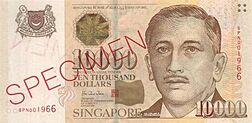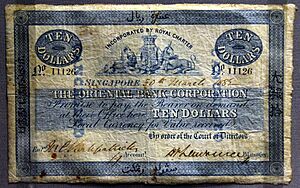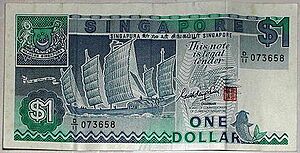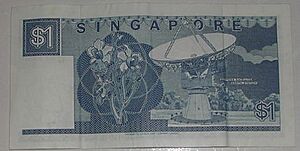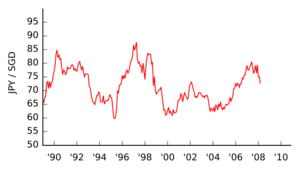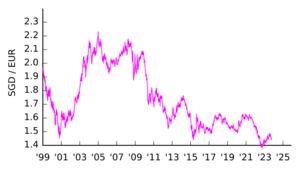Singapore dollar facts for kids
Quick facts for kids Singapore dollar |
|||
|---|---|---|---|
| Dolar Singapura (Malay) 新加坡元 (Chinese) சிங்கப்பூர் வெள்ளி (Tamil) |
|||
|
|||
| ISO 4217 Code | SGD | ||
| User(s) | |||
| Inflation | 0.6% at January 2017 | ||
| Pegged by | Brunei dollar at par | ||
| Subunit | |||
| 1⁄100 | cent | ||
| Symbol | $, S$ | ||
| cent | c | ||
| Nickname | sing-dollar, sing | ||
| Plural | dollars | ||
| cent | cents | ||
| Coins | |||
| Freq. used | 5c, 10c, 20c, 50c, $1 | ||
| Rarely used | 1c (discontinued in 2002 , still legal tender) | ||
| Banknotes | |||
| Freq. used | $2, $5, $10, $50, $100 | ||
| Rarely used | $1, $20, $25, $500 (discontinued, still legal tender); $1,000 (discontinued, still legal tender), $10,000 (discontinued, still legal tender) | ||
| Singapore dollar | |||||||||||
|---|---|---|---|---|---|---|---|---|---|---|---|
| Chinese name | |||||||||||
| Chinese | 新加坡元 | ||||||||||
|
|||||||||||
| Malay name | |||||||||||
| Malay | Dolar/Ringgit Singapura | ||||||||||
| Tamil name | |||||||||||
| Tamil | சிங்கப்பூர் வெள்ளி Ciṅkappūr Veḷḷi | ||||||||||
The Singapore dollar (symbol: S$; code: SGD) is the official money used in Singapore. It is split into 100 cents. You'll often see it written as $ or S$ to tell it apart from other types of dollars. The Monetary Authority of Singapore (MAS) is in charge of making and giving out Singapore's banknotes and coins.
As of 2022, the Singapore dollar is one of the top 10 most traded currencies in the world. Besides being used in Singapore, you can also use the Singapore dollar in Brunei. This is because Singapore and Brunei have a special agreement that allows their currencies to be used in both countries. The Brunei dollar is also accepted in Singapore.
Contents
History of Singapore's Money
For a long time, from the 16th to 19th centuries, the Spanish dollar was widely used in Asia. Later, from 1845 to 1945, the Straits Settlements (which included Singapore) had their own money called the Straits dollar. After that, the Malayan dollar was used, and then the Malaya and British Borneo dollar from 1953.
Singapore continued to use this shared money even after joining Malaysia in 1963 and becoming independent in 1965. However, in 1967, the money agreement between Malaysia, Singapore, and Brunei ended. Singapore then created its own money authority, the Board of Commissioners of Currency, Singapore (BCCS), and started printing its own coins and notes.
At first, the Singapore dollar was linked to the pound sterling, the money of the United Kingdom. Later, it was linked to the U.S. dollar. But as Singapore's economy grew and traded with more countries, it changed how its currency was valued. From 1973 to 1985, Singapore linked its dollar to a secret "basket" of currencies from its main trading partners. This helped control prices and keep Singapore's goods competitive.
Before 1970, many different government groups handled money matters. To make things smoother, the Parliament of Singapore created the Monetary Authority of Singapore (MAS) on January 1, 1971. The MAS was given the power to manage all money, banking, and financial activities in Singapore.
From 1985 onwards, Singapore let its dollar float more freely, but the MAS still watches it closely. This helps the government manage inflation (when prices go up) and make sure Singapore's exports stay strong. On October 1, 2002, the BCCS joined with the MAS, making MAS fully responsible for issuing banknotes.
Money in Circulation
As of 2012, there was about S$57.278 billion worth of Singapore money (notes and coins) being used. All this money is supported by special assets held by the MAS. These assets can include gold, foreign money, government bonds, and other investments. This helps people trust that their money is safe and valuable.
In 2017, the government decided to combine the Currency Fund with other MAS funds. This is because the MAS's total assets (S$395 billion in 2017) are much larger than the Currency Fund (S$55 billion). This change helps the MAS work more efficiently. The government has promised that it will continue to support the value of Singapore's money.
As of July 2022, Singapore's foreign reserves (money held in other currencies) were over US$288.2 billion.
Coins of Singapore
Singapore has introduced several series of coins over the years.
First Series (1967–1985)
In 1967, the first coins were released. They came in 1, 5, 10, 20, and 50 cents, and 1 dollar. These coins showed pictures of wildlife and other things related to Singapore. The 1-cent coin was bronze, while the others were made of copper-nickel. In 1976, the 1-cent coin changed to copper-clad steel. This series was slowly replaced by 1985.
| First Series (Marine Series) (1967–1985) [1] | ||||||||
|---|---|---|---|---|---|---|---|---|
| Value | Technical parameters | Description | Date of issue | |||||
| Diameter | Thickness | Mass | Composition | Edge | Obverse | Reverse | ||
| 1 cent | 17.78 mm | 1.118 mm | 1.940 g | Bronze | Plain | A high-rise public housing block with a fountain in front and clouds in the background | Value and Year | 12 June 1967 |
| 1.744 g | Copper-clad steel | 1976 | ||||||
| 5 cents | 16.26 mm | 1.02 mm | 1.410 g | Cupro-nickel | Milled | A snake-bird sitting in its nest and preening its feathers. | Value and Year | 12 June 1967 |
| 1.260 g | Cupro-nickel clad steel | |||||||
| 5 cents (FAO) | 21.23 mm | 1.27 mm | 1.240 g | Aluminium | A fish and the phrases "INCREASE PRODUCTION" and "MORE FOOD FROM THE SEA." | 1971 | ||
| 10 cents | 19.41 mm | 1.40 mm | 2.83 g | Cupro-nickel | A seahorse with a stylised piece of seaweed. | 12 June 1967 | ||
| 20 cents | 23.60 mm | 1.78 mm | 5.66 g | A swordfish against a background symbolising water. | ||||
| 50 cents | 27.76 mm | 2.03 mm | 9.33 g | A lionfish from tropical waters. | ||||
| $1 | 33.32 mm | 2.39 mm | 16.85 g | A stylised Singapore lion symbol flanked by two stalks of paddy. | ||||
| For table standards, see the coin specification table. | ||||||||
Second Series (1985–2013)
In 1985, a second series of coins was introduced. These coins were smaller and featured different flowers. The 1-dollar banknote was stopped and replaced by a coin made of aluminium-bronze. The 5-cent coin also changed to aluminium-bronze, while the 10, 20, and 50 cents remained copper-nickel. This series is still used today, though the 1-cent coin was taken out of circulation in 2002.
| Second Series (Floral Series) (1985–2013) | ||||||||
|---|---|---|---|---|---|---|---|---|
| Value | Technical parameters | Description | Date of issue | |||||
| Diameter | Thickness | Mass | Composition | Edge | Obverse | Reverse | ||
| 1 cent | 15.90 mm | 1.10 mm | 1.24 g | Copper-plated zinc | Plain | Coat of Arms, "Singapore" in 4 official languages | Value and Vanda 'Miss Joaquim' | 28 September 1987 |
| 5 cents | 16.75 mm | 1.22 mm | 1.56 g | Aluminium bronze | Reeded | Coat of Arms, "Singapore" in 4 official languages | Value and Monstera deliciosa | 2 December 1985 |
| 10 cents | 18.50 mm | 1.38 mm | 2.60 g | Cupronickel | Reeded | Coat of Arms, "Singapore" in 4 official languages | Value and Jasminum multiflorum | 2 December 1985 |
| 20 cents | 21.36 mm | 1.72 mm | 4.50 g | Value and Calliandra surinamensis | ||||
| 50 cents | 24.66 mm | 2.06 mm | 7.29 g | Value and Allamanda cathartica | 2 December 1985 | |||
| Inscribed "Republic of Singapore" and the lion symbol | 28 May 1990 | |||||||
| $1 | 22.40 mm | 2.40 mm | 6.30 g | Aluminium bronze | Reeded with inscription: "Republic of Singapore" and the lion symbol | Coat of Arms, "Singapore" in 4 official languages | Value and Lochnera rosea | 28 September 1987 |
| For table standards, see the coin specification table. | ||||||||
Third Series (2013–Present)
On June 25, 2013, a new series of coins was released. These coins feature famous Singapore landmarks and symbols. For example, the one-dollar coin now shows the Merlion, and the fifty-cent coin features the Port of Singapore. These new coins are made with special materials and features to prevent fakes.
| Third Series (Iconic series) (2013–present) [2] | ||||||||
|---|---|---|---|---|---|---|---|---|
| Value | Technical parameters | Description | Date of issue | |||||
| Diameter | Thickness | Mass | Composition | Edge | Obverse | Reverse | ||
| 5 cents | 16.75 mm | 1.22 mm | 1.70 g | Multi-ply brass-plated steel | Plain | Coat of arms of Singapore, "Singapore" in 4 official languages | Value and The Esplanade | 25 June 2013 |
| 10 cents | 18.50 mm | 1.38 mm | 2.36 g | Multi-ply nickel-plated steel | Alternating plain and reeded | Coat of arms of Singapore, "Singapore" in 4 official languages | Value and Public Housing | 25 June 2013 |
| 20 cents | 21.00 mm | 1.72 mm | 3.85 g | Reeded | Value and Changi International Airport | |||
| 50 cents | 23.00 mm | 2.45 mm | 6.56 g | Micro scalloped | Value and Port of Singapore | |||
| 1 dollar | 24.65 mm | 2.50 mm | 7.62 g | Bi-metallic plating consisting of a brass-plated ring with a nickel-plated centre plug | Reeded | Coat of arms of Singapore, "Singapore" in 4 official languages | Value, The Merlion and a laser mark micro engraving of the Vanda Miss Joaquim | 25 June 2013 |
Singapore Banknotes
Singapore has released several series of banknotes, each with unique designs.
Orchid Series (1967–1976)
The Orchid Series was the first set of banknotes issued in Singapore, from 1967 to 1976. There were nine different values, from $1 to $10,000. Each note featured an orchid design on the front, which is Singapore's national flower. The back of each note showed a different scene from Singapore. All notes also had the Coat of Arms and a lion head watermark for security.
| 1st Series – Orchid Series (1967–1976) [3] | |||||||||||
|---|---|---|---|---|---|---|---|---|---|---|---|
| Image | Value | Dimensions | Main Colour | Description | Date of issue | Issue suspended | Date of withdrawal | Printer | |||
| Obverse | Reverse | Watermark | |||||||||
| [4] | [5] | $1 | 121 mm × 64 mm | Dark blue | Vanda Janet Kaneali | Blocks of flats in a housing estate | Lion's head | 12 June 1967 | 6 August 1976 | Limited | BWC |
| [6] | [7] | $5 | 127 mm × 71 mm | Green | Vanda T.M.A. | A busy scene on the Singapore River | |||||
| [8] | [9] | $10 | 133 mm × 79 mm | Red | Dendrobium Marjorie Ho "Tony Pek" | 4 clasped hands on a background of a map of Singapore | TDLR | ||||
| [10] | [11] | $25 | 140 mm × 79 mm | Brown | Renanthopsis Aurora | Supreme Court Building | 7 August 1972 | 6 August 1979 | |||
| [12] | [13] | $50 | 146 mm × 87 mm | Blue | Vanda Rothscildiana "Teo Choo Hong" | Clifford Pier | 12 June 1967 | 6 August 1976 | |||
| [14] | [15] | $100 | 159 mm × 95 mm | Mid-blue and mauve | Cattleya | A peaceful scene along the Singapore Waterfront | 1 February 1977 | BWC | |||
| [16] | [17] | $500 | 160 mm × 96 mm | Green | Dendrobium Shangri-La | Government Office at Saint Andrew's Road | 7 August 1972 | TDLR | |||
| [18] | [19] | $1,000 | 159 mm × 95 mm | Mauve and dark grey | Dendrobium Kimiyo Kondo "Chay" | Victoria Theatre & Empress Place | 12 June 1967 | 7 August 1978 | |||
| [20] | [21] | $10,000 | 203 mm × 133 mm | Green | Aranda Majulah | The Istana | 29 January 1973 | 1 February 1980 | |||
| For table standards, see the banknote specification table. | |||||||||||
Bird Series (1976–1984)
The Bird Series was the second set of banknotes, issued from 1976 to 1984. It also had nine different values, but the $25 note was replaced by a $20 note. Each note featured a bird on the front, symbolizing Singapore's readiness to grow and achieve great things. Like the Orchid Series, these notes also had the Coat of Arms and a lion head watermark.
| 2nd Series – Bird Series (1976–1984) [22] | |||||||||||
|---|---|---|---|---|---|---|---|---|---|---|---|
| Image | Value | Dimensions | Main Colour | Description | Date of issue | Issue suspended | Date of withdrawal | ||||
| Obverse | Reverse | Watermark | |||||||||
| [23] | [24] | $1 | 125 mm × 63 mm | Blue | Black-naped Tern | National Day Parade | Lion's head | 6 August 1976 | 12 January 1987 | Limited | |
| [25] | [26] | $5 | 133 mm × 66 mm | Green | Red-whiskered Bulbul | Cable cars and aerial view of the harbour | 21 August 1989 | ||||
| [27] | [28] | $10 | 141 mm × 69 mm | Red | White-collared Kingfisher | Garden city with high rise public housing in background | 1 March 1988 | ||||
| [29] | [30] | $20 | 149 mm × 72 mm | Brown | Yellow-breasted Sunbird | Singapore Changi International Airport with the Concorde in the foreground | 6 August 1979 | 1 January 1991 | |||
| [31] | [32] | $50 | 157 mm × 75 mm | Blue | White-rumped Shama | School band on parade | 6 August 1976 | 9 March 1987 | |||
| [33] | [34] | $100 | 165 mm × 78 mm | Blue | Blue-throated Bee-eater | Dancers of various ethnic groups | 1 February 1977 | 1 August 1985 | |||
| [35] | [36] | $500 | 181 mm × 84 mm | Green | Black-naped Oriole | Oil Refinery | 1 March 1988 | ||||
| [37] | [38] | $1,000 | 197 mm × 90 mm | Purple | Brahminy Kite | Container terminal | 7 August 1978 | 22 October 1984 | |||
| [39] | [40] | $10,000 | 203 mm × 133 mm | Green | White-bellied sea-eagle | 2 scenes of the Singapore River | 1 February 1980 | 21 August 1989 | |||
| For table standards, see the banknote specification table. | |||||||||||
Ship Series (1984–1999)
The Ship Series was the third set of banknotes, issued from 1984 to 1999. This series focused on Singapore's history as a port and trading hub. The front of each note showed different types of ships that have sailed in Singapore's waters. The back featured scenes of Singapore's achievements and an orchid. These notes also had the Coat of Arms and a lion head watermark.
| 3rd Series – Ship Series (1984–1999) [41] | |||||||||||
|---|---|---|---|---|---|---|---|---|---|---|---|
| Image | Value | Dimensions | Main Colour | Description | Date of issue | Issue suspended | Date of withdrawal | ||||
| Obverse | Reverse | Watermark | |||||||||
| [42] | [43] | $1 | 125 mm × 63 mm | Blue | "Sha Chuan" | Sentosa Satellite Earth Station | Lion's head | 12 January 1987 | 9 September 1999 | Limited | |
| [44] | [45] | $2 | 133 mm × 63 mm | Red | "Tongkang" | Different ethnic groups participating in Chingay procession. | 28 January 1991 | ||||
| [46] | [47] | $2 | Purple | 16 December 1991 | |||||||
| [48] | [49] | $5 | 133 mm x 66 mm | Green | "Twakow" | View of the Port of Singapore Authority Container terminal | 21 August 1989 | ||||
| [50] | [51] | $10 | 141 mm × 69 mm | Red | Barter trading vessel "Palari" | View of Public Housing | 1 March 1988 | ||||
| [52] | [53] | $50 | 156 mm × 74 mm | Blue | Coaster vessel "Perak" | Bird's-eye view of Benjamin Sheares Bridge | 9 March 1987 | ||||
| [54] | [55] | $100 | 165 mm × 78 mm | Brown | Passenger liner Chusan | Bird's-eye view of Singapore Changi International Airport and a Singapore Airlines Boeing 747 | 1 August 1985 | ||||
| [56] | [57] | $500 | 175 mm × 83 mm | Green | General cargo vessel "Neptune Sardonyx" | Group of men and women from the 3 services of the armed forces and the Civil Defence Force with the outline map of Singapore in the background | 1 March 1988 | ||||
| [58] | [59] | $1,000 | 185 mm × 88 mm | Purple | Container ship "Neptune Garnet" and two container quay cranes | Bird's-eye view of a shipyard | 22 October 1984 | ||||
| [60] | [61] | $10,000 | 195 mm × 93 mm | Red | General bulk carrier "Neptune Canopus" | 1987 National Day Parade | 21 August 1989 | ||||
| For table standards, see the banknote specification table. | |||||||||||
Portrait Series (1999–Present)
The current Portrait series of banknotes started in 1999. These notes feature the face of Yusof Ishak, Singapore's first president, on the front. The back of each note shows a different civic virtue or important aspect of Singaporean life. Both paper and polymer (plastic) notes are in use, with polymer notes slowly replacing the paper ones. Polymer notes feel slightly slippery and have a clear window design. They also have Braille patterns for people with visual impairments.
The S$10,000 and B$10,000 notes were once the most valuable banknotes in the world. However, to help prevent money laundering, the Monetary Authority of Singapore stopped printing new $10,000 notes from October 1, 2014. Banks were told to send these notes back to MAS and not put them back into circulation. Similarly, MAS also stopped producing the S$1,000 banknote from January 1, 2021. However, existing $1,000 and $10,000 notes are still legal to use.
| 4th Series – Portrait Series (1999–present) [62] | |||||||||||
|---|---|---|---|---|---|---|---|---|---|---|---|
| Image | Value | Dimensions | Main Colour | Description | Date of issue | Issue suspended | Date of withdrawal | Material | |||
| Obverse | Reverse | Obverse | Reverse | ||||||||
| $2 | 126 × 63 mm | Violet | President Yusof bin Ishak (1910–1970), Money Cowrie | Education | 9 September 1999 | 12 January 2006 | Current | Paper | |||
| 12 January 2006 | Current | Polymer | |||||||||
| $5 | 133 × 66 mm | Green | President Yusof bin Ishak, Gold-Ringed Cowrie | Garden City | 9 September 1999 | 18 May 2007 | Paper | ||||
| 18 May 2007 | Current | Polymer | |||||||||
| $10 | 141 × 69 mm | Red | President Yusof bin Ishak, Wandering Cowrie | Sports | 9 September 1999 | 4 May 2004 | Paper | ||||
| 4 May 2004 | Current | Polymer | |||||||||
| $50 | 156 × 74 mm | Blue | President Yusof bin Ishak, Cylindrical Cowrie | Arts | 9 September 1999 | Paper | |||||
| $100 | 162 × 77 mm | Orange | President Yusof bin Ishak, Swallow Cowrie | Youth | Paper | ||||||
| $1,000 | 170 × 83 mm | Purple | President Yusof Ishak, Beautiful Cowrie | Government | 1 January 2021 | Paper | |||||
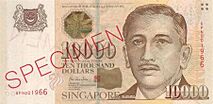 |
$10,000 | 180 × 90 mm | Golden | President Yusof Ishak, Onyx Cowrie | Economics | 1 October 2014 | Gradually withdrawn from circulation | Paper | |||
Special Commemorative Banknotes
Sometimes, special banknotes are released to celebrate important events. These are usually made in limited numbers.
- The first special banknote was released on July 24, 1990, to celebrate Singapore's 25th year of independence. It was a $50 polymer note, and some had a special print of "9 August 1990". This was Singapore's first polymer banknote and the first designed by a Singaporean artist.
- On December 8, 1999, three million $2 millennium notes were released to celebrate the year 2000. They looked like the regular $2 notes but had a special Millennium 2000 logo.
- On June 27, 2007, a special S$20 note was launched to mark 40 years of the currency agreement with Brunei. Its back design matched the Brunei $20 note released at the same time.
- On August 18, 2015, a set of six special notes was launched for Singapore's 50th birthday (SG50). This set included five S$10 notes and one S$50 note. The designs showed important moments and values in Singapore's history, like its multi-racial society. The $50 note featured Lee Kuan Yew shouting "Merdeka!" (meaning "freedom!"). The $10 notes highlighted themes like "Caring Community" and "Strong Families."
- In 2017, both Brunei and Singapore issued special $50 polymer banknotes to celebrate 50 years of their Currency Interchangeability Agreement.
- On June 5, 2019, a $20 note was issued to mark the Singapore Bicentennial, celebrating 200 years since modern Singapore was founded.
| Singapore commemorative banknotes | ||||||||||
|---|---|---|---|---|---|---|---|---|---|---|
| Value | Dimensions | Main Colour | Occasion | Description | Date of issue | Material | Ref. | |||
| Obverse | Reverse | |||||||||
| $50 | 156 × 74 mm | Red | 25th Anniversary of the Independence of Singapore | Optically variable device shows President Yusof bin Ishak, Singapore Harbour in 1861, four blossoms of the "Vanda Miss Joaquim" orchid, Tanjong Pagar container port and some prominent office buildings | 1st Parliament of Singapore held on 8 December 1965 and group of multi-racial Singaporeans in jubilant celebration | 24 July 1990 | Polymer | |||
| $25 | 141 × 79 mm | Brown | 25th Anniversary of the Monetary Authority of Singapore | Monetary Authority of Singapore Building set against a view of Singapore's financial district and scene of the SIMEX trading floor | Singapore's financial sector skyline | 10 May 1996 | Paper | |||
| $20 | 149 × 72 mm | Orange | 40 Years of the Currency Interchangeability Agreement | President Yusof bin Ishak and the "Dendrobium Puan Noor Aishah" orchid | The Esplanade, skyline of Singapore's financial district and the Omar Ali Saifuddien Mosque with the Royal Barge and the water village shown | 27 June 2007 | Polymer | |||
| $50 | 156 × 74 mm | Gold | SG50: Celebrating Singapore's 50 years of nation-building | President Yusof bin Ishak, Prime Minister Lee Kuan Yew and a group of children of different races and gender | First National Day Parade 1966 and the Punggol New Town | 11 August 2015 | Polymer | |||
| $10 | 141 × 69 mm | Red | President Yusof bin Ishak and the "Vanda Miss Joaquim" orchid | "…regardless of race, language or religion…" | 11 August 2015 | Polymer | ||||
| $10 | 141 × 69 mm | Red | "Opportunities for All" | 11 August 2015 | Polymer | |||||
| $10 | 141 × 69 mm | Red | "Safe and Secure" | 11 August 2015 | Polymer | |||||
| $10 | 141 × 69 mm | Red | "Strong Families" | 11 August 2015 | Polymer | |||||
| $10 | 141 × 69 mm | Red | "Caring Community, Active Citizenry" | 11 August 2015 | Polymer | |||||
| $50 | 158 × 75 mm | Gold | 50 Years of the Currency Interchangeability Agreement | President Yusof bin Ishak, the "Vanda Miss Joaquim" orchid, the "Simpur" flower and the window security feature showing Brunei Darussalam's Istana Nurul Iman and Singapore's Istana | Military personnel from the Royal Brunei Armed Forces and the Singapore Armed Forces, students from both countries, Brunei Darussalam's Ulu Temburong National Park and Singapore Botanic Gardens | 5 July 2017 | Polymer | |||
| $20 | 162 × 77 mm | Beige-Peach | Singapore Bicentennial | President Yusof bin Ishak, National Gallery Singapore (former Supreme Court and City Hall) | Eight pioneering individuals, namely Munshi Abdullah, Henry Nicholas Ridley, Tan Kah Kee, P. Govindasamy Pillai, Teresa Hsu Chih, Alice Pennefather, Adnan Saidi and Ruth Wong Hie King, portrayed against a backdrop of the Singapore River | 5 June 2019 | Polymer | |||
| These images are to scale at 0.7 pixel per millimetre. For table standards, see the banknote specification table. | ||||||||||
How Exchange Rates Work
Current Exchange Rates
| Current SGD exchange rates | |
|---|---|
| From Google Finance: | AUD CAD CHF EUR GBP HKD JPY USD IDR MYR |
| From Yahoo! Finance: | AUD CAD CHF EUR GBP HKD JPY USD IDR MYR |
| From XE.com: | AUD CAD CHF EUR GBP HKD JPY USD IDR MYR |
| From OANDA: | AUD CAD CHF EUR GBP HKD JPY USD IDR MYR |
| From fxtop.com: | AUD CAD CHF EUR GBP HKD JPY USD IDR MYR |
| Rank | Currency | ISO 4217 code (symbol) |
% daily share (April 2016) |
|||||||||||||||||||||||||||||||||||||||||||||||||||||||||||||||||||||||||||||||||||||||||||||||||||||||||||||||||||||||||||||||||||||||||||||||||||||||||||||||||||||||||||||||||||||||||||||||||||||||||||||||||||||||||||||||||||
|---|---|---|---|---|---|---|---|---|---|---|---|---|---|---|---|---|---|---|---|---|---|---|---|---|---|---|---|---|---|---|---|---|---|---|---|---|---|---|---|---|---|---|---|---|---|---|---|---|---|---|---|---|---|---|---|---|---|---|---|---|---|---|---|---|---|---|---|---|---|---|---|---|---|---|---|---|---|---|---|---|---|---|---|---|---|---|---|---|---|---|---|---|---|---|---|---|---|---|---|---|---|---|---|---|---|---|---|---|---|---|---|---|---|---|---|---|---|---|---|---|---|---|---|---|---|---|---|---|---|---|---|---|---|---|---|---|---|---|---|---|---|---|---|---|---|---|---|---|---|---|---|---|---|---|---|---|---|---|---|---|---|---|---|---|---|---|---|---|---|---|---|---|---|---|---|---|---|---|---|---|---|---|---|---|---|---|---|---|---|---|---|---|---|---|---|---|---|---|---|---|---|---|---|---|---|---|---|---|---|---|---|---|---|---|---|---|---|---|---|---|---|---|---|---|---|---|---|---|---|---|
|
|
|
87.6% | ||||||||||||||||||||||||||||||||||||||||||||||||||||||||||||||||||||||||||||||||||||||||||||||||||||||||||||||||||||||||||||||||||||||||||||||||||||||||||||||||||||||||||||||||||||||||||||||||||||||||||||||||||||||||||||||||||||
|
|
|
31.4% | ||||||||||||||||||||||||||||||||||||||||||||||||||||||||||||||||||||||||||||||||||||||||||||||||||||||||||||||||||||||||||||||||||||||||||||||||||||||||||||||||||||||||||||||||||||||||||||||||||||||||||||||||||||||||||||||||||||
|
|
|
21.6% | ||||||||||||||||||||||||||||||||||||||||||||||||||||||||||||||||||||||||||||||||||||||||||||||||||||||||||||||||||||||||||||||||||||||||||||||||||||||||||||||||||||||||||||||||||||||||||||||||||||||||||||||||||||||||||||||||||||
|
|
|
12.8% | ||||||||||||||||||||||||||||||||||||||||||||||||||||||||||||||||||||||||||||||||||||||||||||||||||||||||||||||||||||||||||||||||||||||||||||||||||||||||||||||||||||||||||||||||||||||||||||||||||||||||||||||||||||||||||||||||||||
|
|
|
6.9% | ||||||||||||||||||||||||||||||||||||||||||||||||||||||||||||||||||||||||||||||||||||||||||||||||||||||||||||||||||||||||||||||||||||||||||||||||||||||||||||||||||||||||||||||||||||||||||||||||||||||||||||||||||||||||||||||||||||
|
|
|
5.1% | ||||||||||||||||||||||||||||||||||||||||||||||||||||||||||||||||||||||||||||||||||||||||||||||||||||||||||||||||||||||||||||||||||||||||||||||||||||||||||||||||||||||||||||||||||||||||||||||||||||||||||||||||||||||||||||||||||||
|
|
|
4.8% | ||||||||||||||||||||||||||||||||||||||||||||||||||||||||||||||||||||||||||||||||||||||||||||||||||||||||||||||||||||||||||||||||||||||||||||||||||||||||||||||||||||||||||||||||||||||||||||||||||||||||||||||||||||||||||||||||||||
|
|
|
4.0% | ||||||||||||||||||||||||||||||||||||||||||||||||||||||||||||||||||||||||||||||||||||||||||||||||||||||||||||||||||||||||||||||||||||||||||||||||||||||||||||||||||||||||||||||||||||||||||||||||||||||||||||||||||||||||||||||||||||
|
|
|
2.2% | ||||||||||||||||||||||||||||||||||||||||||||||||||||||||||||||||||||||||||||||||||||||||||||||||||||||||||||||||||||||||||||||||||||||||||||||||||||||||||||||||||||||||||||||||||||||||||||||||||||||||||||||||||||||||||||||||||||
|
|
|
2.1% | ||||||||||||||||||||||||||||||||||||||||||||||||||||||||||||||||||||||||||||||||||||||||||||||||||||||||||||||||||||||||||||||||||||||||||||||||||||||||||||||||||||||||||||||||||||||||||||||||||||||||||||||||||||||||||||||||||||
|
|
|
1.9% | ||||||||||||||||||||||||||||||||||||||||||||||||||||||||||||||||||||||||||||||||||||||||||||||||||||||||||||||||||||||||||||||||||||||||||||||||||||||||||||||||||||||||||||||||||||||||||||||||||||||||||||||||||||||||||||||||||||
|
|
|
1.8% | ||||||||||||||||||||||||||||||||||||||||||||||||||||||||||||||||||||||||||||||||||||||||||||||||||||||||||||||||||||||||||||||||||||||||||||||||||||||||||||||||||||||||||||||||||||||||||||||||||||||||||||||||||||||||||||||||||||
|
|
|
1.7% | ||||||||||||||||||||||||||||||||||||||||||||||||||||||||||||||||||||||||||||||||||||||||||||||||||||||||||||||||||||||||||||||||||||||||||||||||||||||||||||||||||||||||||||||||||||||||||||||||||||||||||||||||||||||||||||||||||||
|
|
|
1.7% | ||||||||||||||||||||||||||||||||||||||||||||||||||||||||||||||||||||||||||||||||||||||||||||||||||||||||||||||||||||||||||||||||||||||||||||||||||||||||||||||||||||||||||||||||||||||||||||||||||||||||||||||||||||||||||||||||||||
|
|
|
1.7% | ||||||||||||||||||||||||||||||||||||||||||||||||||||||||||||||||||||||||||||||||||||||||||||||||||||||||||||||||||||||||||||||||||||||||||||||||||||||||||||||||||||||||||||||||||||||||||||||||||||||||||||||||||||||||||||||||||||
|
|
|
1.4% | ||||||||||||||||||||||||||||||||||||||||||||||||||||||||||||||||||||||||||||||||||||||||||||||||||||||||||||||||||||||||||||||||||||||||||||||||||||||||||||||||||||||||||||||||||||||||||||||||||||||||||||||||||||||||||||||||||||
|
|
|
1.1% | ||||||||||||||||||||||||||||||||||||||||||||||||||||||||||||||||||||||||||||||||||||||||||||||||||||||||||||||||||||||||||||||||||||||||||||||||||||||||||||||||||||||||||||||||||||||||||||||||||||||||||||||||||||||||||||||||||||
|
|
|
1.1% | ||||||||||||||||||||||||||||||||||||||||||||||||||||||||||||||||||||||||||||||||||||||||||||||||||||||||||||||||||||||||||||||||||||||||||||||||||||||||||||||||||||||||||||||||||||||||||||||||||||||||||||||||||||||||||||||||||||
|
|
|
1.0% | ||||||||||||||||||||||||||||||||||||||||||||||||||||||||||||||||||||||||||||||||||||||||||||||||||||||||||||||||||||||||||||||||||||||||||||||||||||||||||||||||||||||||||||||||||||||||||||||||||||||||||||||||||||||||||||||||||||
|
|
|
1.0% | ||||||||||||||||||||||||||||||||||||||||||||||||||||||||||||||||||||||||||||||||||||||||||||||||||||||||||||||||||||||||||||||||||||||||||||||||||||||||||||||||||||||||||||||||||||||||||||||||||||||||||||||||||||||||||||||||||||
| Other | 7.1% | |||||||||||||||||||||||||||||||||||||||||||||||||||||||||||||||||||||||||||||||||||||||||||||||||||||||||||||||||||||||||||||||||||||||||||||||||||||||||||||||||||||||||||||||||||||||||||||||||||||||||||||||||||||||||||||||||||||
Total
|
||||||||||||||||||||||||||||||||||||||||||||||||||||||||||||||||||||||||||||||||||||||||||||||||||||||||||||||||||||||||||||||||||||||||||||||||||||||||||||||||||||||||||||||||||||||||||||||||||||||||||||||||||||||||||||||||||||||
Exchange Rate Charts
See also
 In Spanish: Dólar de Singapur para niños
In Spanish: Dólar de Singapur para niños
- Economy of Singapore
Images for kids


